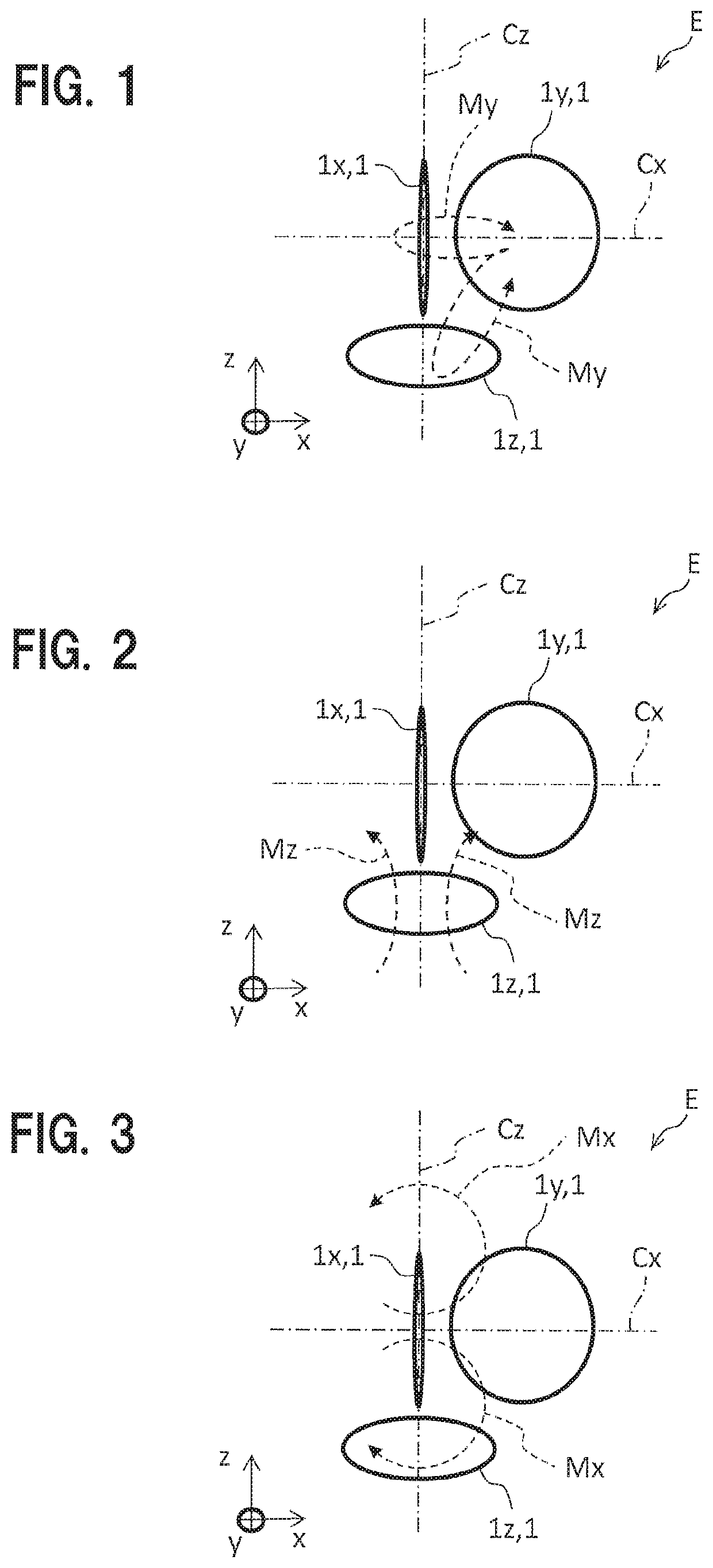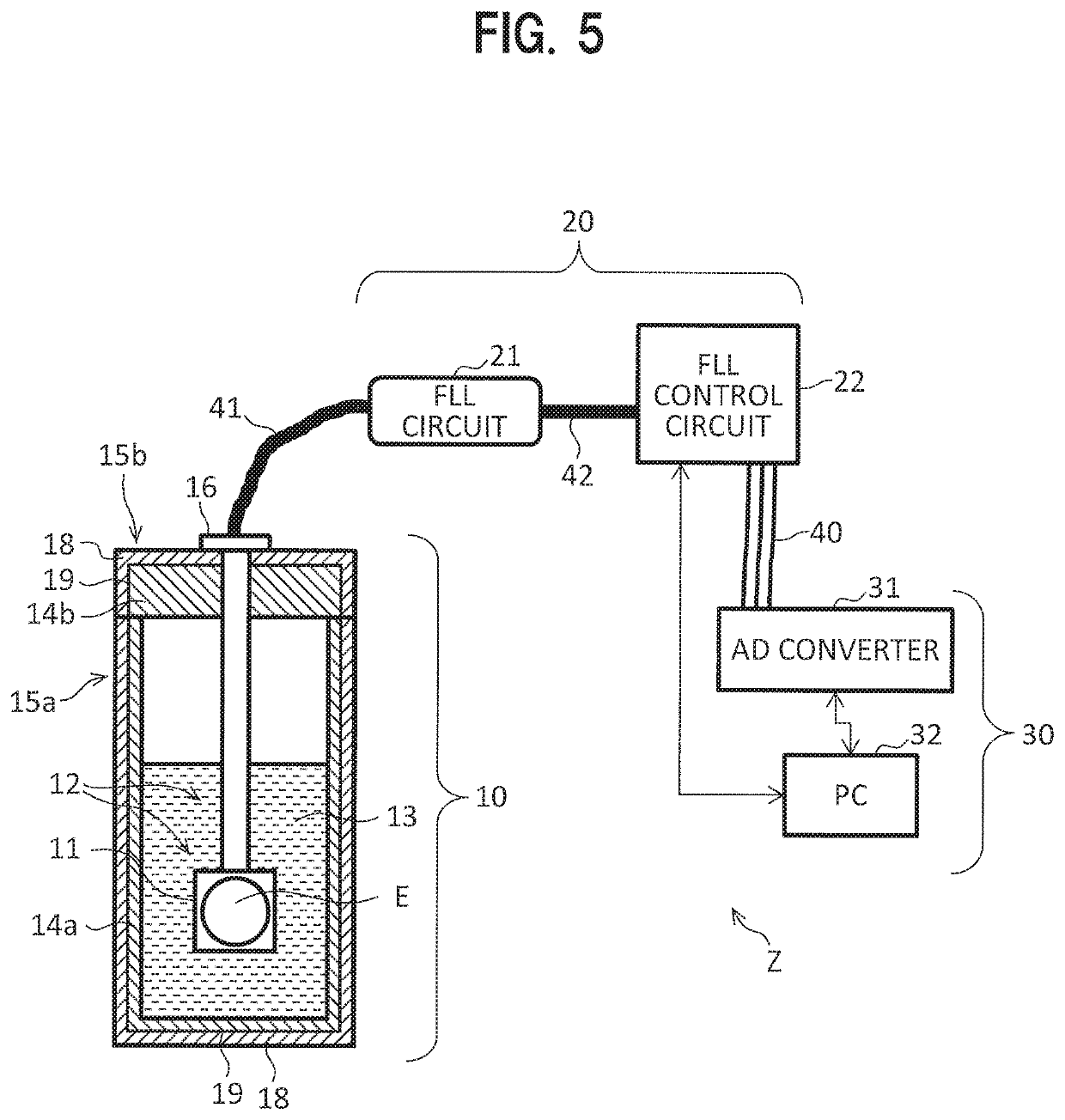Magnetic field measuring element, magnetic field measuring device, and magnetic field measuring system
- Summary
- Abstract
- Description
- Claims
- Application Information
AI Technical Summary
Benefits of technology
Problems solved by technology
Method used
Image
Examples
first embodiment
(Configuration of Magnetic Field Measuring Element E)
[0089]FIGS. 1 to 3 are diagrams each illustrating an example of arrangement of coils in a magnetic field measuring element E according to a first embodiment. Note that in FIGS. 1 to 4, SQUID magnetic sensors 1x to 1z represent detection coils 3 and the other components are omitted so as to make it easy to understand the pictures. In addition, each SQUID magnetic sensor 1 has substantially the same structure as of FIG. 31.
[0090]The SQUID magnetic sensor 1z (1), which is the first SQUID magnetic sensor, is disposed on a plane (first plane) perpendicular to the z axis. Specifically, the SQUID magnetic sensor 1z is horizontally placed with respect to the ground. The SQUID magnetic sensor 1x (1), which is the second SQUID magnetic sensor, is disposed on the central axis Cz that extends, from the center of the SQUID magnetic sensor 1z, vertically with respect to the detection plane of the SQUID magnetic sensor 1z.
[0091]Specifically, th...
second embodiment
[0111]FIG. 4 is a diagram illustrating positional relation between SQUID magnetic sensors 1 in a magnetic field measuring element Ea according to a second embodiment.
[0112]In the magnetic field measuring element E shown in FIGS. 1 to 3, the SQUID magnetic sensors 1x and 1y are disposed at the same height relative to the SQUID magnetic sensor 1z. Specifically, the center of the SQUID magnetic sensor 1y is disposed on the central axis Cx. As such, the height of the whole magnetic field measuring element E shown in FIGS. 1 to 3 is made lower. That is, in the magnetic field measuring element E shown in FIGS. 1 to 3, the SQUID magnetic sensors 1x to 1z are arranged so as to equal the distance from the bottom surface of the magnetic field measuring element E (the coil surface of the SQUID magnetic sensor 1z) to the upper end of each of the SQUID magnetic sensors 1x and 1y. However, the arrangement is acceptable as long as the respective SQUID magnetic sensors 1 are in parallel relation or...
third embodiment
(Magnetic Field Measuring System Z)
[0116]FIG. 5 illustrates function blocks as a configuration example of a magnetic field measuring system Z according to an embodiment of the invention.
[0117]The magnetic field measuring system Z includes a magnetic field measuring unit (magnetic field measuring device) 10, which is a cryostat, a control circuit unit 20, and a data processing unit 30. Note that in FIG. 5, the magnetic field measuring unit 10 is represented by a schematic cross-sectional view.
[0118]The magnetic field measuring unit 10 includes a magnetic field measuring element E having, as components, a plurality of SQUID magnetic sensors 1 for measuring a magnetic flux.
[0119]In addition, the control circuit unit 20 is to control the magnetic field measuring unit 10 and has an FLL circuit 21 and an FLL control circuit 22. The FLL circuit 21 and the FLL control circuit 22 will be described below.
[0120]Further, the data processing unit 30 is to record magnetic signals, detected by the...
PUM
 Login to View More
Login to View More Abstract
Description
Claims
Application Information
 Login to View More
Login to View More - R&D
- Intellectual Property
- Life Sciences
- Materials
- Tech Scout
- Unparalleled Data Quality
- Higher Quality Content
- 60% Fewer Hallucinations
Browse by: Latest US Patents, China's latest patents, Technical Efficacy Thesaurus, Application Domain, Technology Topic, Popular Technical Reports.
© 2025 PatSnap. All rights reserved.Legal|Privacy policy|Modern Slavery Act Transparency Statement|Sitemap|About US| Contact US: help@patsnap.com



